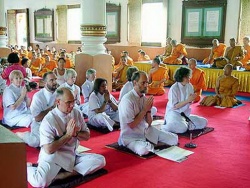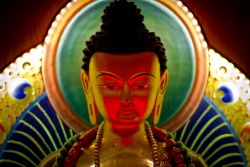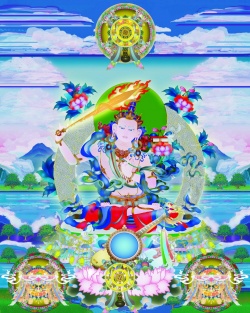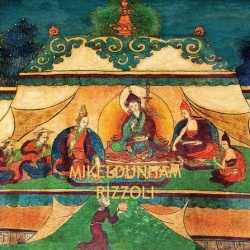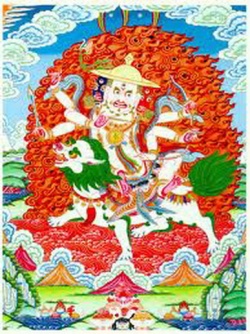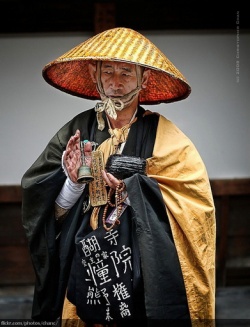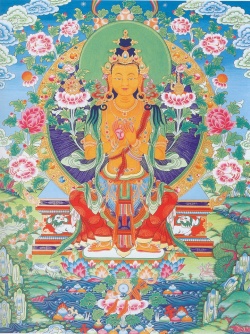The Tree of Enlightenment: An Introduction to the Major Traditions of Buddhism - Chapter Twenty-Seven: The Preliminary Practices
The Tree of Enlightenment
An Introduction to the Major Traditions of Buddhism
Peter Della Santina
Chapter Twenty-Seven
The Preliminary Practices
In Chapters 22 through 26, I tried to outline what we might call the universe of experience of the Vajrayana. That is why I began with a consideration of the cultural and intellectual climate in which the Vajrayana first appeared, and only then went on to consider its religious and philosophical background, methodology, myth and symbol, and psychology, physiology, and cosmology. In Chapters 27 through 29, I will look at the actual stages in the practice of the Vajrayana path. In general, there are three such stages: (1) the preliminary or preparatory stage, (2) the stage of entry, and (3) the actual practice. I have divided the preliminary stage into two categories: general and specific.
As mentioned in Chapter 22, the Mahayana and Vajrayana are in fact two components of a single tradition. Their starting point and goal are identical; they differ only in the methods employed in getting from that starting point to the goal. From this we can understand that, in terms of general preliminaries, there is a great deal of similarity between what is required for Mahayana practice and what is required for Vajrayana practice.
We need to touch on the preliminaries briefly to emphasize again that the Vajrayana practices are not ones that can be undertaken without the proper kind of preparation. In fact, the general preliminaries required for Vajrayana practice are those required for the whole of the Mahayana path. In this category of general preliminary practices, we have (1) the taking of refuge, followed by (2) contemplation of suffering, (3) the law of karma, (4) death and impermanence, and (5) the opportune and fortunate nature of the human situation; (6) cultivation of love and compassion; and (7) production of the enlightenment thought. We conclude with (8) cultivation of one-pointedness, or concentration, and penetrative insight. All these serve as a general prerequisite to Vajrayana practice.
With a few exceptions, the general preliminary practices of the Vajrayana are similar to those of the Mahayana. One of the exceptions is the way the taking of refuge is practiced. Whereas in the Mahayana tradition there are the three objects of refuge--the Enlightened One, his teaching, and the Noble Assembly of the irreversible Bodhisattvas or Bodhisattvas who have attained the seventh stage of the Bodhisattva path and are therefore not liable to relapse, in the Vajrayana there is also the fourth refuge--the preceptor (the guru or lama). In certain traditions within the Vajrayana fold, there may be as many as six objects of refuge, the two additional ones being the tutelary deities and the dakinis. The tutelary deities are the special esoteric forms of the Buddha who are any one of the major tantric deities--Hevajra, Chakrasamvara, and the like--meditation upon whom is a complete path to enlightenment. The dakinis are female deities who are symbolic or representative of insubstantiality. In the Vajrayana pantheon, the dakinis occupy a position in some ways analogous to that of the Noble Assembly, being the special tantric or Vajrayana forms of the Sangha. Although in certain traditions and contexts we do have references to these six objects of refuge, it is far more common to find the four objects of refuge, that is, the preceptor and the Triple Gem.
The preceptor is particularly important in the Vajrayana tradition. Let me refer to two ideas that illustrate the role and importance of the preceptor in the Vajrayana tradition. First, the preceptor performs a function similar to that of a magnifying glass. We know that the sun is very hot and has great power, yet without a device like the magnifying glass we cannot harness its heat to kindle a fire. Similarly, although the Buddha and his teachings are very powerful, without the preceptor they are unable to kindle the fire of wisdom within a disciple. The preceptor functions as a means of concentrating and harnessing the power of the Buddha, Dharma, and Sangha in such a way as to make that power effective and immediately applicable to the disciple's own needs.
Recognizing this role of the preceptor has always been of the greatest importance. We will understand this better if we consider the story of Marpa, one of the more famous Tibetans who journeyed to India in order to receive the Vajrayana teaching from Naropa. Marpa made three journeys to India and studied at length with Naropa. It is said that on one occasion, when the manifestation of a tutelary deity appeared before him, Marpa made the mistake of bowing to the appearance of the deity rather than to his preceptor, Naropa. The karmic consequences of this lapse were that Marpa later lost his sons to accidents and had no descendants to whom he could pass on the teachings he had received. This is one of a number of stories which indicate the need to recognize the importance of the preceptor in the Vajrayana tradition.
In Chapter 29, I will show how the last two components in these general preliminaries--the cultivation of single-pointedness and penetrative insight--are applied to one's practice in the context of Vajrayana meditation. For the time being, let me repeat that these general preliminaries are indispensable prerequisites to serious Vajrayana practice. No tradition within Tibetan Buddhism encourages the commencement of Vajrayana practice without having spent a really substantial amount of time on these preliminary practices. All the Tibetan Vajrayana traditions have extensive oral and written material on the cultivation and practice of these preliminaries. Although it does sometimes happen that people go on to Vajrayana practice without having spent an appropriate amount of time on these general preliminaries, they do so at their own risk. However, I do not mean to indulge in scare mongering. What I mean is that if you do somehow manage to go on to your university education without having undergone pre-university training, you are liable to have a much more difficult time in your university career.
I would like to make one more observation before treating the particular preliminary practices that are special to the Vajrayana. I have gone to great lengths to show the integrated nature of the three major Buddhist traditions of Theravada, Mahayana, and Vajrayana, and have tried to show that the Vajrayana represents a natural extension of elements found in other Buddhist traditions. I would therefore like to draw your attention to two steps in these general preliminary practices: the taking of refuge, and the awakening of the enlightenment thought, or acceptance of the Bodhisattva vows. I would like to suggest that these can be regarded as initiations of a kind. Another practice which may be seen as analogous to initiation is the novitiate, or entrance into the Buddhist Order.
All three of these practices may be thought of as varieties of initiations. All involve entrance into a community with a particular set of practices: in the case of taking refuge, the ceremony represents entry into the Buddhist community; in the case of the novitiate, it represents entry into the monastic community; and in the case of the Bodhisattva vows, entry into the lineage or family of the Buddha. These three ceremonies are, in a sense, initiations that involve taking on certain commitments: taking refuge brings along with it the commitment to try to observe the precepts of a layperson; entering the monastic order brings with it the commitment to observe the precepts of a novice; and taking the Bodhisattva vows brings with it the commitments of the Bodhisattva. There are aspects of the institutions of refuge, novitiate, and Bodhisattva vows that are similar to important elements in the Vajrayana initiation.
Let us go on to look at the specific preliminary practices generally required for Vajrayana practice. It is not imperative that one complete the preliminaries before beginning any kind of Vajrayana practice. It is also not imperative that one complete these preliminaries before receiving Vajrayana initiation. It is, however, imperative that one complete them before undertaking meditational retreat on one of the major Vajrayana tutelary deities. For really serious Vajrayana practice, these specific preliminaries are required.
The term for these preliminaries in Tibetan is ngon-dro, which literally means 'going before.' Hence these practices go before serious practice. There are four specific preliminary practices common to all the Vajrayana traditions: (1) refuge, (2) confession, (3) preceptor yoga, and (4) mandala offering. Each has to be performed one hundred thousand times. In addition to these four, certain traditions require the performance of prostrations, and others require alternative rituals.
Refuge. As already mentioned, in the Vajrayana tradition one takes refuge in four 'objects'--the Buddha, Dharma, Sangha, and preceptor, or guru. Taking refuge involves visualization of the objects of refuge either separately or together: (a) one can visualize one's preceptor, the Buddha, the texts, and the Noble Assembly separately, or (b) one can visualize the four objects of refuge integrated or combined into the single figure of the tutelary deity. Some of you may have seen this visualization portrayed in painted scrolls, with the objects of refuge pictured in a tree, on a jeweled throne, on a lotus and a sun or moon disk (for more on some of these symbols, see Chapter 25). Using this visualization of the four objects of refuge, we recite a refuge formula one hundred thousand times.
Confession. For convenience, I have called the second specific preliminary practice 'confession' because it is commonly referred to by this name. However, it is important to remember here that we are not concerned with confession as a means of securing forgiveness. We do not use the term in the same sense in which it is used in Christianity, where the confession of sins is followed by forgiveness from an external power. In this context, confession merely implies our own recognition of unwholesome actions done in the past, and our resolve not to repeat them. Especially important in this practice of confession of unwholesome actions is the Buddha Vajrasattva, another special form of the Buddha similar to the Buddhas of the Five Families. Vajrasattva is an archetypal form of the Buddha who embodies the state of enlightenment for the special purpose of the confession and purification of unwholesome actions.
Vajrasattva appears in the Mahayana pantheon as well, and the practice of confession of unwholesome actions is one of the preliminaries performed by all who embark on the Bodhisattva path. Vajrasattva is white in color. He has a single face and two hands, and holds a vajra and a bell, which stand for skillful means and wisdom, respectively. In the specific preliminary practice of confession, we meditate on Vajrasattva and recite the hundred-syllable mantra of Vajrasattva one hundred thousand times.
It is said that four powers issue from the practice of the confession and purification of unwholesome actions. The first power is the 'power of the shrine,' which refers to the power of Vajrasattva as a symbol of purification. There is a certain power which issues from visualization of the form of Vajrasattva. This is a symbolic power, similar to the kind of power that issues, in the mundane context, from a symbol such as the national flag. The national flag has a symbolic power; similarly, in the sacred context of meditation, the image of Vajrasattva has a certain power, the power of symbol.
The second of the four powers is the 'power of transcendence,' of going beyond. This refers to a sincere renunciation of unwholesome actions. In other words, in the course of the meditation, unwholesome actions are transcended.
The third power that issues from this practice is the 'power of habitual antidote,' or the power of persistent correction, which refers to the sincere resolve not to repeat the unwholesome actions one has done in the past. This is the power to refrain from doing unwholesome actions again in the future.
The fourth power is the 'power of restoration.' This refers to the fact that, insofar as unwholesome actions belong to the level of conditioned reality, they do not really penetrate to the core of one's own being, which is the Buddha mind, or the nature of emptiness. Unwholesome actions are, in reality, adventitious. They are like the dirt that soils a white cloth, or the smoke or cloud that obscures the sky. Because of this, meditation on Vajrasattva results in the power of restoration, which is the realization of our intrinsic purity.
Preceptor Yoga. The third preliminary is called preceptor yoga. The preceptor (guru or lama) is an accomplished master who bestows tantric initiations and special spiritual attainments. Although it is quite common for those not conversant with the Tibetan tradition to refer to any Tibetan monk as a lama, in the Tibetan tradition this term is reserved for such qualified masters, while ordinary monks are referred to simply as gelong (bhikshu). The term yoga means 'yoking together,' connecting or identifying.
The purpose of preceptor yoga is to establish a close bond between disciple and master. Here again, we can see the importance of the preceptor in the Vajrayana tradition. This practice can take different forms, which differ slightly. However, in general it involves the recitation, one hundred thousand times, of a formula that expresses a disciple's devotion to and regard for the qualities of the preceptor.
I would like to expand on what I said earlier about the importance of the preceptor in the Vajrayana tradition--why this is and must be so. The Vajrayana tradition is first and foremost an oral tradition, handed down from master to disciple. The association or connection between master and disciple is particularly important. This association leads to the formation of lineage. Lineage is, of course, important not only in the Vajrayana but also in the Buddhist tradition as a whole, especially when it comes to monastic ordination. If you look at the history of monasticism in Sri Lanka and Thailand, you will notice the importance accorded to it. Because of discontinuation of the lineage of monastic ordination, special envoys had to be sent from one Theravada country to another on a number of occasions, simply to renew the lineage.
Lineage is like an electric circuit. When the lineage is broken, the ordination of new disciples cannot take place. This also occurred in the monastic history of Tibet when, after the persecution of Buddhism under King Lan-dar-ma, the lineage of monastic ordination had to be reestablished with the help of Chinese monks. Thus lineage is extremely important. It is important in the Vajrayana tradition because it is by means of lineage--the unbroken chain connecting master and disciple--that the Vajrayana teachings are handed down from one generation to the next.
The concept of lineage implies the identity of each link in the chain, each member of the lineage. Consequently, the figure of the preceptor secures identification between the master, disciple, and tutelary deity. Later, the disciple him or herself forges this bond as he or she develops his or her own sense of identification with the preceptor and then with the tutelary deity.
The institution of the lineage, as it is embodied in the figure of the preceptor, cuts across time and space. It bridges the gulf that separates us, here and now, from the time and place and mode of being of the Buddha. This is why, in Vajrayana initiation and meditation practice, the preceptor is identified with the tutelary deity, and it is then the task of the practitioner to identify with the deity through the preceptor. This practice of union with the guru is important for creating the foundation of the special relationship between practitioner and preceptor.
Mandala Offering. The fourth preliminary practice is the offering of the mandala. In general, a mandala is a sacred, symbolic (or magic) circle. In the context of the offering ritual, the mandala represents in symbolic form the whole mundane universe, as it is pictured in traditional Buddhist cosmology. Traditionally, the universe is said to have Mount Sumeru at its center, the four continents on each side of Mount Sumeru, four intermediate continents, and so forth. The mandala is a symbolic representation of this traditional cosmology.
In the practice of mandala offering, the practitioner offers to the four objects of refuge (the Buddha, Dharma, Sangha, and preceptor) all his own merit, born of wholesome actions, in the symbolic form of the universe. He offers all his wholesome actions to these four objects, which are the repositories of all excellent qualities, for the sake of the enlightenment of all sentient beings. This offering is done a hundred thousand times. Along with the recitation, the practitioner performs a ritual using a disk of metal, stone, or wood and grains of rice, wheat, or sand, by means of which he creates symbolically the salient features of the traditional cosmology of the universe.
This practice of mandala offering is effective because it is the most excellent form of karma. There are five modifying conditions that intensify the weight of karma--three subjective and two objective. The three subjective conditions are (a) persistence or repetition of an action, (b) willful intention, and (c) absence of regret. The objective conditions are (d) quality and (e) indebtedness toward whom the action is directed (see also Chapter 8).
In the mandala offering, we have all the conditions conducive to enhancing the weight of this wholesome karma. We have persistence, in that the offering is done a hundred thousand times. We have the intention of the practitioner to offer all his merits in this symbolic form to the enlightened ones. We also have a complete absence of regret. If we were to offer material objects, we might be liable to experience some feeling of regret. For example, if I offer a financial endowment to a monastery, I may later think that I have offered too much. But with a symbolic offering of this sort, there is no ground for that kind of feeling to arise, so the wholesome karma it generates is unopposed. Last, who is more worthy of offering than the enlightened ones, who are of the highest worth and greatest benefit to us, since it is they who make enlightenment accessible? The practice of mandala offering thus creates the merit required to make rapid progress along the Vajrayana path.
In short, the four specific preliminary practices have a special contribution to make in the preparation for serious Vajrayana practice. The recitation of the refuge formula establishes one firmly on the path, creating a secure shelter that protects one from discouragement and distractions. The practice of confession purifies unwholesome actions. The practice of preceptor yoga identifies practitioner and preceptor, establishing the relationship so crucial to one's progress on the Vajrayana path. Finally, the practice of mandala offering creates the positive potential, the wholesome energy, that one needs in making rapid and efficient strides.
Continue Reading
Part One: The Fundamentals of Buddhism
- The Tree of Enlightenment: An Introduction to the Major Traditions of Buddhism - Chapter One: Buddhism: A Modern Perspective
- The Tree of Enlightenment: An Introduction to the Major Traditions of Buddhism - Chapter Two: The Pre-Buddhist Background
- The Tree of Enlightenment: An Introduction to the Major Traditions of Buddhism - Chapter Three: The Life of the Buddha
- The Tree of Enlightenment: An Introduction to the Major Traditions of Buddhism - Chapter Four: The Four Noble Truths
- The Tree of Enlightenment: An Introduction to the Major Traditions of Buddhism - Chapter Five: Morality
- The Tree of Enlightenment: An Introduction to the Major Traditions of Buddhism - Chapter Six: Mental Development
- The Tree of Enlightenment: An Introduction to the Major Traditions of Buddhism - Chapter Seven: Wisdom
- The Tree of Enlightenment: An Introduction to the Major Traditions of Buddhism - Chapter Eight: Karma
- The Tree of Enlightenment: An Introduction to the Major Traditions of Buddhism - Chapter Nine: Rebirth
- The Tree of Enlightenment: An Introduction to the Major Traditions of Buddhism - Chapter Ten: Interdependent Origination
- The Tree of Enlightenment: An Introduction to the Major Traditions of Buddhism - Chapter Eleven: The Three Universal Characteristics
- The Tree of Enlightenment: An Introduction to the Major Traditions of Buddhism - Chapter Twelve: The Five Aggregates
- The Tree of Enlightenment: An Introduction to the Major Traditions of Buddhism - Chapter Thirteen: The Fundamentals in Practice
Part Two: The Mahayana
- The Tree of Enlightenment: An Introduction to the Major Traditions of Buddhism - Chapter Fourteen: The Origins of the Mahayana Tradition
- The Tree of Enlightenment: An Introduction to the Major Traditions of Buddhism - Chapter Fifteen: The Lotus Sutra
- The Tree of Enlightenment: An Introduction to the Major Traditions of Buddhism - Chapter Sixteen: The Heart Sutra
- The Tree of Enlightenment: An Introduction to the Major Traditions of Buddhism - Chapter Seventeen: The Lankavatara Sutra
- The Tree of Enlightenment: An Introduction to the Major Traditions of Buddhism - Chapter Eighteen: The Philosophy of the Middle Way
- The Tree of Enlightenment: An Introduction to the Major Traditions of Buddhism - Chapter Nineteen: The Philosophy of Mind Only
- The Tree of Enlightenment: An Introduction to the Major Traditions of Buddhism - Chapter Twenty: The Development of Mahayana Philosophy
- The Tree of Enlightenment: An Introduction to the Major Traditions of Buddhism - Chapter Twenty-One: Mahayana Buddhism in Practice
- The Tree of Enlightenment: An Introduction to the Major Traditions of Buddhism - Chapter Twenty-Two: The Origins of the Vajrayana Tradition
Part Three: The Vajrayana
- The Tree of Enlightenment: An Introduction to the Major Traditions of Buddhism - Chapter Twenty-Three: Philosophical and Religious Foundations
- The Tree of Enlightenment: An Introduction to the Major Traditions of Buddhism - Chapter Twenty-Four: Methodology
- The Tree of Enlightenment: An Introduction to the Major Traditions of Buddhism - Chapter Twenty-Five: Myth and Symbolism
- The Tree of Enlightenment: An Introduction to the Major Traditions of Buddhism - Chapter Twenty-Six: Psychology, Physiology, and Cosmology
- The Tree of Enlightenment: An Introduction to the Major Traditions of Buddhism - Chapter Twenty-Seven: The Preliminary Practices
- The Tree of Enlightenment: An Introduction to the Major Traditions of Buddhism - Chapter Twenty-Eight: The Vajrayana Initiation
- The Tree of Enlightenment: An Introduction to the Major Traditions of Buddhism - Chapter Twenty-Nine: Vajrayana Buddhism in Practice
- The Tree of Enlightenment: An Introduction to the Major Traditions of Buddhism - Chapter Thirty: An Introduction to the Abhidharma
Part Four: The Abhidharma
- The Tree of Enlightenment: An Introduction to the Major Traditions of Buddhism - Chapter Thirty-One: Philosophy and Psychology in the Abhidharma
- The Tree of Enlightenment: An Introduction to the Major Traditions of Buddhism - Chapter Thirty-Two: Methodology
- The Tree of Enlightenment: An Introduction to the Major Traditions of Buddhism - Chapter Thirty-Three: Analysis of Consciousness
- The Tree of Enlightenment: An Introduction to the Major Traditions of Buddhism - Chapter Thirty-Four: The Form and Formless Spheres
- The Tree of Enlightenment: An Introduction to the Major Traditions of Buddhism - Chapter Thirty-Five: Supramundane Consciousness
- The Tree of Enlightenment: An Introduction to the Major Traditions of Buddhism - Chapter Thirty-Six: Analysis of Mental States
- The Tree of Enlightenment: An Introduction to the Major Traditions of Buddhism - Chapter Thirty-Seven: Analysis of Thought-Processes
- The Tree of Enlightenment: An Introduction to the Major Traditions of Buddhism - Chapter Thirty-Eight: Analysis of Matter
- The Tree of Enlightenment: An Introduction to the Major Traditions of Buddhism - Chapter Thirty-Nine: Analysis of Conditionality
- The Tree of Enlightenment: An Introduction to the Major Traditions of Buddhism - Chapter Forty: The Thirty-Seven Factors of Enlightenment
- The Tree of Enlightenment: An Introduction to the Major Traditions of Buddhism - Chapter Forty-One: Abhidharma in Daily Life
